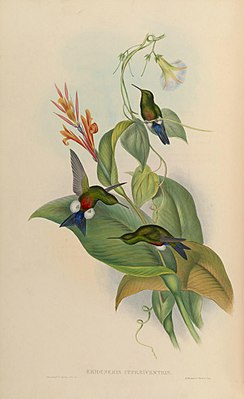Copper-bellied panty hummingbird
| Copper-bellied panty hummingbird | ||||||||||||
|---|---|---|---|---|---|---|---|---|---|---|---|---|

Copper-Bellied Panty Hummingbird illustrated by John Gould and Henry Constantine Richter |
||||||||||||
| Systematics | ||||||||||||
|
||||||||||||
| Scientific name | ||||||||||||
| Eriocnemis cupreoventris | ||||||||||||
| ( Fraser , 1840) |
The copper-bellied hummingbird ( Eriocnemis cupreoventris ) or sometimes copper- bellied snow pant is a species of bird from the hummingbird family (Trochilidae) that is widespread in Venezuela and Colombia . The IUCN assesses the population as “ Near Threatened ” . The species is considered to be monotypical .
features
The copper-bellied hummingbird with pants reaches a body length of about 9 to 10 cm and a weight of 4.2 to 5.6 g. The beak is straight and black. The male has a green shimmer on the upper side, which turns blue-green on the upper tail-coverts. The underside glitters green, whereby this turns into a golden copper in the middle of the belly. The coverts under the tail shimmer purple, which contrasts with the forked blue-black tail and the white fluffy tufts of feathers on the legs. Both sexes are similar, but the female has grayish white spots on the throat and a less copper-colored underside. Young animals have a blackish breast and the belly lacks the copper color.
Behavior and nutrition
The copper-bellied hummingbird behaves very aggressively and territorially at sources of nectar such as flowering trees and scrub. He flies to plants with short petals , prefers z. B. from the genera Palicourea , Cavendishia and Pernettya . He clings to the plants to take in nectar. He first observes insects that he hunts in flight from his seat.
Vocalizations
The song of the copper-bellied hummingbird consists of individual metallic tsik tones, which it repeats at irregular intervals. He utters these while sitting and in a hovering flight .
Reproduction
The breeding season of the copper-bellied hummingbird is from September to January. He likes to build the relatively large nest in dense vegetation. The clutch consists of two white eggs and the incubation is carried out exclusively by the female. The first brood occurs in the second year of life of the birds.
distribution and habitat
The copper-bellied hummingbird prefers open vegetation such as the edges of mountain forests, mountain slopes with scrub and open páramo . Occasionally he is also out and about in the damp forest. It does not normally travel in the upper subtropical and colder zones, but occasionally it reaches the high altitudes of the Páramo. It occurs at altitudes of 2000 to 3000 meters, but it is mostly absent above 2500 meters. It is distributed in the Andes of Mérida in northwest Venezuela, and in the east of Colombia south to the Departamento de Cundinamarca .
migration
The copper-bellied hummingbird is generally considered to be a stationary bird or a line bird that migrates at high altitudes.
Etymology and history of research
The first description of the copper belly panties hummingbirds carried out in 1840 by Louis Fraser under the scientific name Trochilus cupreo-ventris . The type specimen was in the collection of Edward Smith-Stanley, 13th Earl of Derby and allegedly came from Santa Fé de Bogotá . In 1849 Heinrich Gottlieb Ludwig Reichenbach introduced the new genus Eriocnemis , which was later assigned to the copper-bellied hummingbird. This name is derived from the Greek words »erion ἔριον « for »wool« and »knēmis κνημίς « for »cuff, leg splint «. The species name »cupreoventris« is a Latin word from »cypreus, cyprium« for »copper-colored, copper« and »venter, ventris« for »belly«.
literature
- Iris Heynen, Peter Boesman in: Josep del Hoyo , Andrew Elliott, Jordi Sargatal , David Andrew Christie , Eduardo de Juana: Coppery-bellied Puffleg (Eriocnemis cupreoventris) in Handbook of the Birds of the World Alive . Lynx Edicions, Barcelona.
- James A. Jobling: Helm Dictionary of Scientific Bird Names . Christopher Helm, London 2010, ISBN 978-1-4081-2501-4 .
- Louis Fraser: Mr. Fraser pointed out the character of several new species of Humming-birds, which have been placed in his hands by Earl of Derby for this purpose, and that they might be exhibited at one of the Society's scientific meetings. In: Proceedings of the Zoological Society of London . tape 8 , no. 86 , 1840, pp. 14-19 ( biodiversitylibrary.org ).
- Heinrich Gottlieb Ludwig Reichenbach: Avium systema naturale. The natural system of birds with a hundred panels, mostly original illustrations of the almost twelve hundred typical shapes discovered so far. Forerunner of an iconography of the species of birds of all parts of the world, which, after almost three thousand illustrations have already appeared, is being continued without interruption. Friedrich Hofmeister, Leipzig 1849 ( books.google.de ).
Web links
- Eriocnemis cupreoventris inthe IUCN Red List of Threatened Species 2019.2. Listed by: BirdLife International, 2016. Retrieved October 10, 2019.
- BirdLife International: Species Factsheet - Coppery-bellied Puffleg ( Eriocnemis cupreoventris ) . Retrieved October 10, 2019.
- Videos, photos and sound recordings of Coppery-bellied Puffleg (Eriocnemis cupreoventris) in the Internet Bird Collection
- Copper-bellied hummingbird ( Eriocnemis cupreoventris ) at Avibase; accessed on October 10, 2019.
- Eriocnemis cupreoventris in the Integrated Taxonomic Information System (ITIS). Retrieved on 2019-10-10.
- xeno-canto: sound recordings - copper-bellied hummingbird ( Eriocnemis cupreoventris )
- Coppery-bellied Puffleg (Eriocnemis cupreoventris) in the Encyclopedia of Life . Retrieved October 10, 2019.
Individual evidence
Remarks
- ↑ Reichenbach only provided a table with the characteristics of the genus. He did not assign a specific type in the first publication.

